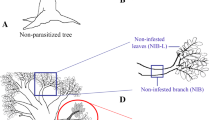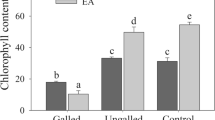Abstract
The onset of biotic stress in the host plants as a result of increased insect population size leads to enhanced levels of secondary metabolites and associated phenolic enzyme activity. Of the three host plants examined, viz.Ricinus communis (castor),Eucalyptus globulus (eucalyptus) andManihot utilissima (tapioca), castor was the host most preferred byRetithrips syriacus. Despite the fact that tapioca had the highest levels of secondary compounds, thrips infestation persisted. However, fecundity and growth were reduced because of the relatively high levels of primary metabolites. Gallic acid was found to be the most toxic of the phenolic acids, followed by pyrogallol, resorcinol, phloroglucinol and vanillic acid. The less toxic phenolic acids and flavanoids were detected in leaves that harboured thrips, while the preponderance of gallic acid was found in uninfested hosts. Thus the interaction ofRetithrips syriacus with the hosts is governed essentially by the biochemical profiles of its hosts, which tend to be altered subsequent to infestation, thus manifesting induced resistance through enhanced production of phenolics
Similar content being viewed by others
References
Ananthakrishnan T N 1956 On the incidence ofRetithrips syriacus on castor in Madras (South India);Zool. Anz. 157 33–35
Ananthakrishnan T N 1990 Facets of chemical ecology in insect-plant interactions: An overview;Proc. Indian Acad. Sci. (Anim. Sci.) 99 177–183
Bate-Smith E C 1962 Attractants and repellents in higher animals; inPhytochemical ecology (ed) J B Harborne (London: Academic Press)
Bray H C and Thorpe W 1954 Analysis of phenolic compounds of interest in metabolism;Meth. Biochem. Anal. 1 27–52
Chippendale G M 1978 The function of carbohydrates in insect life processes; inBiochemistry of insects (ed) M Rockstein (London: Academic Press) pp 2–54
Dadd R H 1983 Essential fatty acids; insects and vertebrates compared; inMetabolic aspects of lipid nutrition in insects (eds) T M Mitter and R H Dadd (Colorado: West View Press) pp 107–147
Dobie F 1977 The contribution of the tropical stored products centre to the study of insect resistance in stored maize;Trop. Strd. Prd. Inf. 34 7–22
Dubois M, Cilles K A, Hamilton J K, Rebers P A and Smith F 1956 Colorimetric determination of sugars and related substances;Anal. Chem. 28 351–356
Harborne J B 1984Phytochemical methods. A guide to modern techniques of plant analysis (London: Chapman and Hall)
Haslam E 1985 New polyphenols for old tannins; inAnnual Proceedings of the Phytochemical Society of Europe (eds) Van Sumere and P J Lea (Oxford: Clarendon Press) vol. 25, pp 237–256
Higuchi T 1966 Role of phenylalanine deaminase and tyrase in the lignification of bamboo;Agric. Biol. Chem. 30 667–673.
Howard D F, Blum M S and Fales H M 1983 Defense in thrips: Forbidding fruitiness of lactone;Science 220 335–336
Howard D F, Blum M S, Jones T H, Fales H M and Tomalski M D 1987 Defensive function and chemistry of the anal exudate of the Cuban laurel thripsGynalkothrips ficorum (Marchal);Phytophaga 1 163–170
Jayaraj S and Uthamaswamy S 1990 Aspects of insect resistance in crop plants:Proc. Indian Acad. Sci. (Anim. Sci.) 99 211–224
Loebenstein G and Linsey N 1961 Peroxidase activity in virus infected sweet potatoes;Phytopathology 51 533–537
Lowry O H, Resebrough N J, Farr A L and Randall R J 1951 Protein measurements with the folin phenol reagent:J. Biol. Chem. 193 265–275
Moore H and Stein W S 1948 Photometric ninhydrin method for use in the chromatography of amino acids;J. Biol. Chem. 176 367–388
Palmer J K 1963 Banana polyphenol oxidase—preparation and properties;Plant Physiol. 38 508–513
Rockstein M 1978 edBiochemistry of insects (New York: Academic Press)
Schuster R 1985 Determination of fatty acids in margarine and butter by on-column derivatization HPLC application; Hewlett-Packard Publication No. 12 5826–5954
Suresh G and Ananthakrishnan T N 1988 Leaf age correlated changes in oxidative enzymes inRetithrips syriacus (Mayet) infestedRicinus communis;Curr. Sci. 57 744–746
Todd G W 1971 Resistance in barley to the greenbugSchizaphis graminum 1. Toxicity of phenolic and flavanoid compounds and related substances;Ann. Entomol. Soc. Am. 64 718–722
Visser J H and Ave D A 1978 General green leaf volatiles in the olfactory orientation of the Colorado beetleLeptinotarsa decemlineata;J. Exp. Appl. Entomol. 24 538–549
Wasilla M G and Venkataraman T V 1967 A simple method for counting leaf hopper eggs inserted in plant tissue;Curr. Sci. 36 319
Whittaker R H and Feeny P 1971 Allelochemics: chemical interactions between species;Science 171 757–770
Author information
Authors and Affiliations
Rights and permissions
About this article
Cite this article
Ananthakrishnan, T.N., Gopichandran, R. & Gurusubramanian, G. Influence of chemical profiles of host plants on the infestation diversity ofRetithrips syriacus . J Biosci 17, 483–489 (1992). https://doi.org/10.1007/BF02720103
Received:
Revised:
Issue Date:
DOI: https://doi.org/10.1007/BF02720103




